Very new to electronics. Stuck on this topic: In a circuit with zero resistance an ideal voltage source of example 5 volts will produce 5 volts, since ideal voltages don't have an internal resistance. But does that not go against Kirchhoff's voltage law that the sum voltage of a closed circuit should be zero? In this example with no resistance the sum will be 5 volts and not zero. What am I misunderstanding?
-
1Yes, all these "idealities" are contradictory. Like an infinitely strong wall being hit by infinite force. – Eugene Sh. Jan 13 '22 at 18:59
-
3You're talking about shorting out an ideal voltage source, which also implies infinite current. Things break down when you start using ideal models in contradictory situations. – Hearth Jan 13 '22 at 19:00
-
2Does this answer your question? [Different and opposing voltage sources?](https://electronics.stackexchange.com/questions/195354/different-and-opposing-voltage-sources) – The Photon Jan 13 '22 at 19:59
2 Answers
It does not lead to a contradiction in circuits where KVL is still applicable. KVL states that the voltage around a loop shall be zero, and a simple circuit where this model is useful looks like this:

simulate this circuit – Schematic created using CircuitLab
and indeed, the voltage around the loop is zero - there's a voltage drop of 5 V across the load.
There is a KVL contradiction when you apply a short-circuit to the ideal voltage source, or if you connect two different-valued voltage sources to the same nodes. These are artificial contradictions, simply because you've chosen an oversimplified model (ideal voltage sources and/or ideal short circuits). This does not mean that the model is universally bad, since it still held well when we had a real load, but it does mean that the model has limitations.
These are not the only types of problems with KCL/KVL. For example, when your wires are long enough compared to the wavelength of high-speed signals, KCL/KVL are unable to model certain electromagnetic effects that occur (example).
- 18,062
- 2
- 47
- 73
It's not exactly a violation of KVL. Consider what happens if the two supply terminals are connected by a resistor with zero resistance, which is what you are doing. Then the current through the resistor will be infinite, and you can use Ohms' Law to say that e = iR becomes 5 = infinity x 0.
Well, that is certainly true, in the sense that infinity = 5/0, but it's the sort of thing that leads to problems. There are methods for dealing with divide-by-zero situations, but at this point in your educations don't even go there.
So the rule with KVL and a voltage source is never to use a resistance of zero, and never use a current source with an infinite resistance.
- 59,978
- 2
- 37
- 97